Fairytale Montegiovi
a place that lights romantic quests
Montegiovi will catch your imagination from your very first glimpse from afar. And then again as it introduces itself as you reach the summit of a hill on the road to Castel del Piano. Silhouetted on the top of a cone of a hill, with the thick chestnut forest foothills of Maremma's volcanic mountain, Monte Amiata, behind. Or, from the opposite direction, against a seemingly endless backdrop of pale, rolling "Colline Senese" hills.
In either case, at that one and same moment it will light a quest within you to visit to meet it in person. A romantic quest that has no roots in rhyme or reason, for there are so many other picturesque hill top villages in Tuscany beckoning you to visit. But which, nonetheless, you will follow. For you must.
I first saw Montegiovi when the sun was setting and those same said Sienese hills were all a glow in shades of pink and orange.
And to any guys reading this, no I am not exaggerating the prose, although I may be apt to do so on other occasions. The Sienese hills do turn pink and orange in the early evening sun. And then purple. Take your girl there to see them ;)
Montegiovi was silhouetted in shades of purple-grey against an orange-red sky and the lights coming from its windows were sparkling like tiny stars.
With a car full of children to get home for dinner, I couldn't stop even though I so very much wanted to. But just hours later, whilst my not so best culinary efforts were on the stove, I checked my map and made plans to return. Which I did one early November morning.
The view from the top of the lane down to Seggiano.
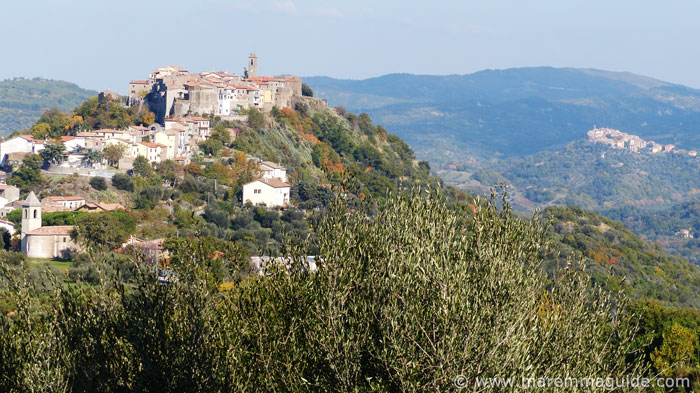
I stopped here to eat my panino whilst staring at that view. And, at first bite, a local leaving his olive grove alongside stopped his van, wound down his window, smiled, and wished me ""Buon apetito!". Only in Italy does someone, a complete stranger, do that when you are tucking into your sandwich :) Even if it was a huge one from my local deli!
Admittedly, "fairytale" Montegiovi isn't home to any fairies! Sorry kids! And once you get there, there really isn't much to "see". So, why am I writing about it?
Well, because it is a normal, lived in village. And such a very, very quiet place.
It is special because of just that.
Less than two hundred people live there today.
This is non-prettified, authentic Tuscany that you should visit whilst it is as it is. There isn't a tourist souvenir shop in sight. In fact there aren't any shops. And as far as tourists go, I don't think Montegiovi has seen any since the Touring Club Italiano put it's "Altitude M 526" sign up on a visit many, many years ago.
But when you do start to walk around, you'll discover that what caught your imagination from afar was once a castle and that you are inside the thing "to see". Because for the most part the village is still enclosed in its "vecchia mura" - ancient castle walls. Not a huge castle, but what was once a strategic one whose street plan is still intact today.
Montegiovi. You'll either be bored or love it for what it is
The atmospheric view from afar (from Seggiano). Montegiovi is that tiny place on top of that wooded mound. The captivating castle down below in the foreground is Castello di Potentino.
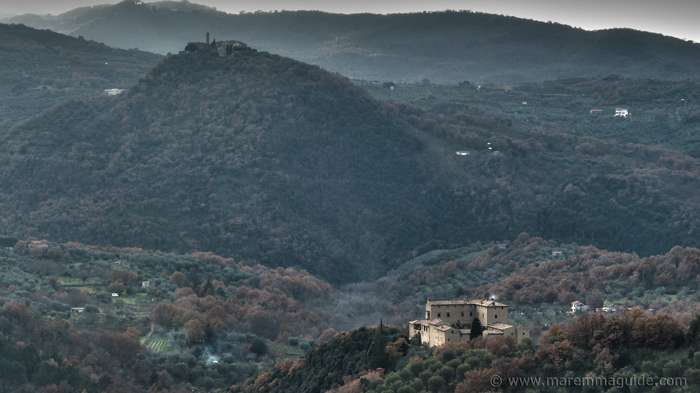
Around the base of the hill flow the courses of not two, but three rivers: the Lente, the Zancona and the Vivo.
Getting closer on a sunny early November morning from the road on the other side of that hill that takes you past Montenero and Montegiovi to Castel del Piano.

Closer still.

The view a week before on the 1 November, with Maremma's Monte Amiata mountain behind and smoke trailing from a "tidying-up" fire in the woods. Yes, I visited twice!
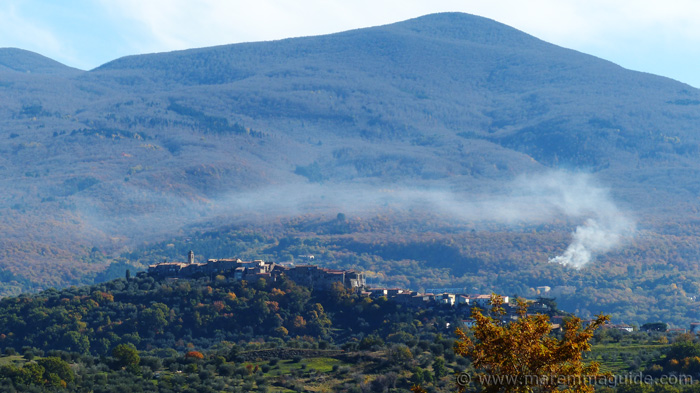
And the winter landscape on a snowing February day. (Thanks Marco).

Drive down that lane and at its end your eye will catch sight of this lovely lemon coloured house on the right.
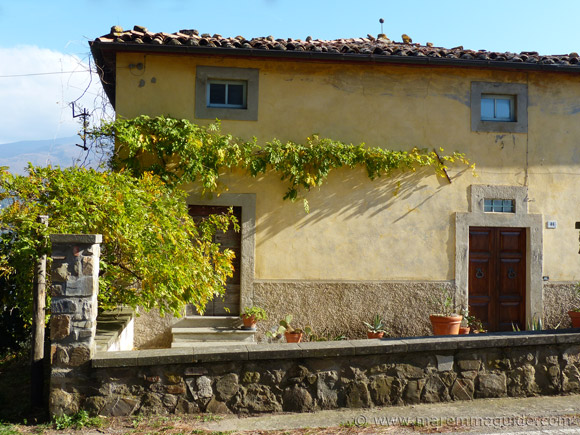
Which sits in front of the Chapel of Slaves.
The Oratory of the Slaves
Montegiovi has two churches and a chapel. This one, the Chiesa della Madonna degli Schiavi (the Church of the Madonna of the Slaves) - also now known as the Chiesa della Madonna delle Grazie - was called the Oratory of the Slaves when it was first built in the 16th century.
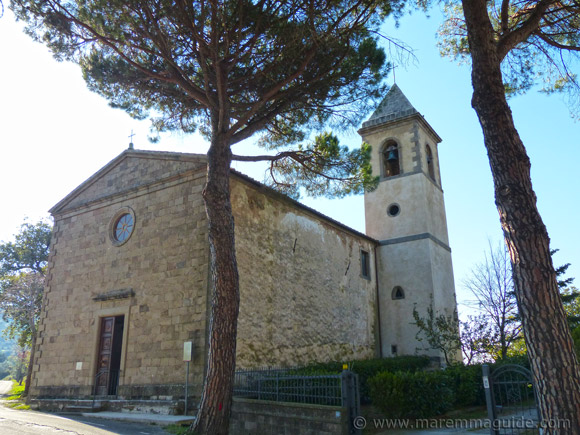
The bell tower was added during a rebuild between 1852 and 1869.
If you pop inside, you'll find one of the original public notices announcing the programme for the two day "festa" (holiday) on the 25th and 26th September 1869, to celebrate the opening of the new church.
And if you take a close look you will see that, apart for the benediction on the first morning, there was also a solemn procession to transport the relic of the Madonna from Montegiovi's parochial church to her new home. Various symphonies by the Philharmonic orchestra of CasteldelPiano (now written Castel del Piano). And two silk flag waving competitions - one on each day - with prizes of 45 and 50 lire each.
Fifty lire then was a grand prize indeed, amounting to not less than 5,000 Euros today. (The best estimate I could find, although it does sound too high. If any of you reading this happen to do that kind of calculation in your sleep, could you take a look for me and let me know what you come up with? Thanks.)
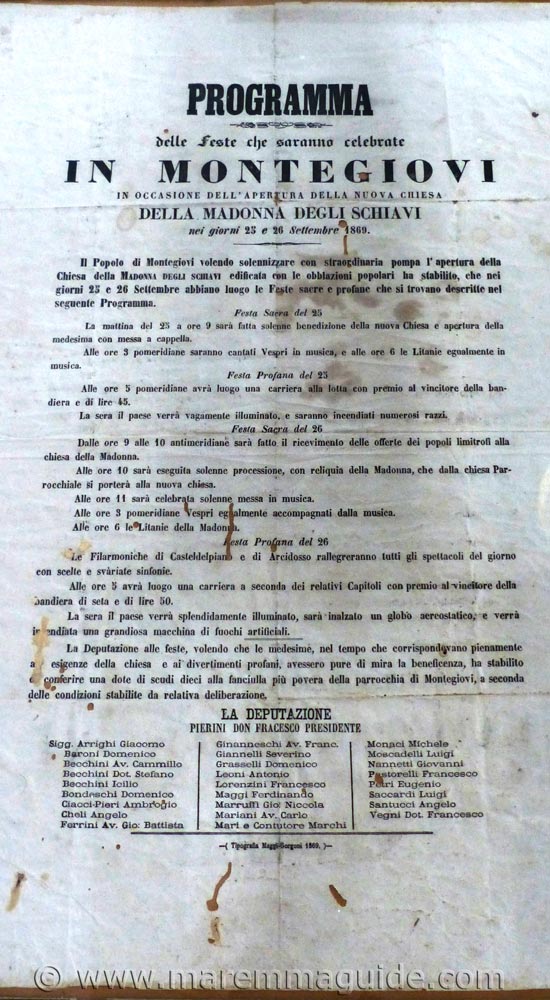
The Chiesa della Madonna degli Schiavi is also the home to a fifteenth century fresco with two "Angeli adoranti" (adoring angels) in flight added to it by a Baroque painter whose works you will find in a lot of churches her in the Monte Amiata area; Francesco Nasini. He added them sometime during his lifetime in the seventeenth century, between 1611 and 1695.
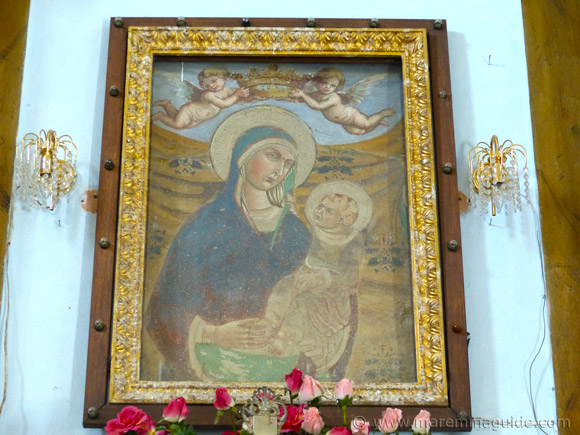 Madonna col Bambino.
Madonna col Bambino.
The Castello di Montegiovi - the castle
Surviving documentary records tell us that Montegiovi's castle is more than 800 years old, but in all probability it's first origins are much older than that.
The earliest document is dated in the year 1209, issued by German King Otto IV the same year he became Holy Roman Emperor. In it he confirms the division of the ownership of the castle in two equal shares. Between the Bishop of Chiusi and the Abbot of the Abbazia di Sant'Antimo di San Salvatore in Monte Amiata.
By 1217, and for two centuries thereafter, it was controlled by influential and noble Sienese families. First-up, Siena's most illustrious family, the Tolomei dynasty. Then the Bonsignori family - the originators and owner of the "Gran Tavola", the largest European bank in the 13th century that regularly lent huge sums of money to European kings before it went broke.
At the same time as they owned Montegiovi, the Bonsignori family also owned many nearby castles including the Potentino castle in the photograph above, and the nearest neighbour down the road on a lower hill, the castle of Montenero d'Orcia.
By 1368 Montegiovi belonged to the Salimbeni family and in the second half of the fourteenth century it was given to the noble lady Antonia Salimbeni, who managed to keep it through two marriages until her death in 1411.
Her first husband was Francesco Casale, Lord of Cortona, and their wedding saw the initiation of the very first balestro - flag waving competition - in Cortona as part of the wedding celebrations. You can see them there on the second Sunday of June each year.
After Francesco Casale's death, in 1409 she married Giacomo Attendolo Sforza, Count of Cotignola and founder of the Sforza dynasty. Antonia was his first wife, but by that time he had already had eight children by two mistresses. And on the year of their marriage another was born by his mistress Lucia Terzani - making the count of their offspring eight - and two years later, the year that Antonia's own son was born and she died, a ninth.
Giacomo - nicknamed Muzio - Sforza, married twice more, having five more legitimate children.
Don't you just find the details of history fascinating!
The outer castle walls
The perimetry castle walls.
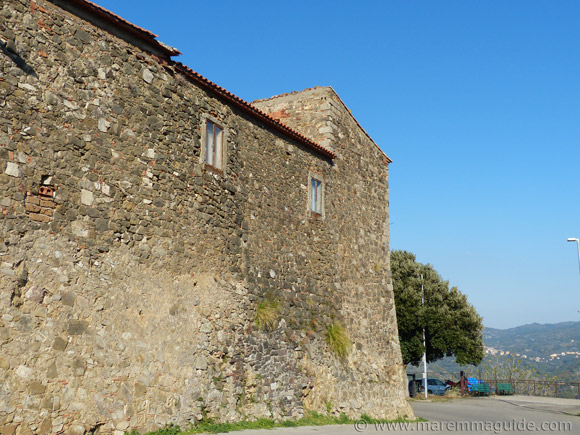
Still lived in today.
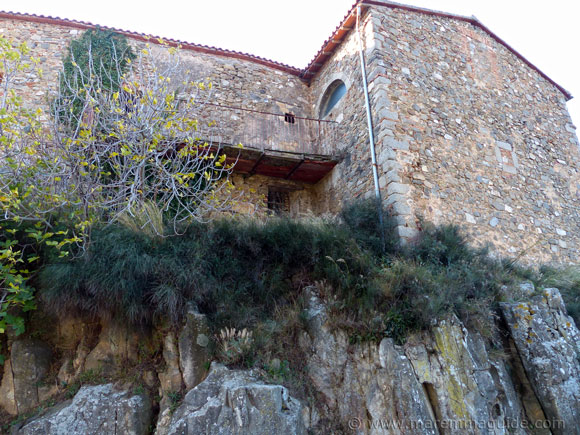
And in bloom.

Getting inside
The medieval entrance gateway - the Porta di Sant'Elena - with that Touring Club Italiano sign and the chapel of Sant'Elena inside.
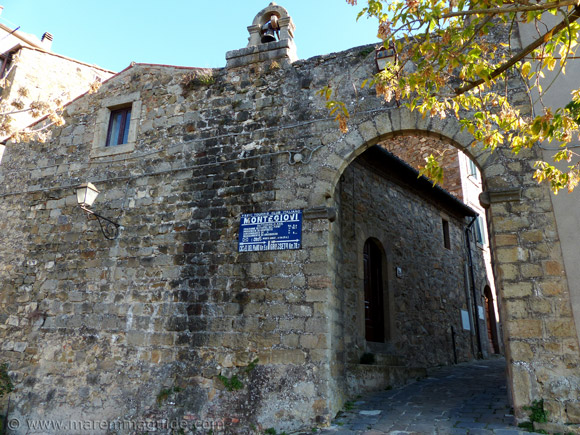
Inside looking out. The "cappella" of Saint Rocco and Saint Elena was once the castle chapel.

Inside Montegiovi's castle looks like this...

Yes, I have added a photo filter! Because I wanted to share what, even whilst walking around on a sunlit November morning, it felt to me that the place would have been like in the high middle ages, all those centuries ago. Darker for sure. Damp for sure too.
And an altogether more oppressive place that stood witness to Italy's darkest period. A time of family feuds of unmitigated bloody violence, and a gang war game of power between the Guelphs and Ghibelline political parties. Much as I am fascinated by medieval history, I would not have wanted to have lived at that time. Especially as a woman!
Today Montegiovi looks like this...

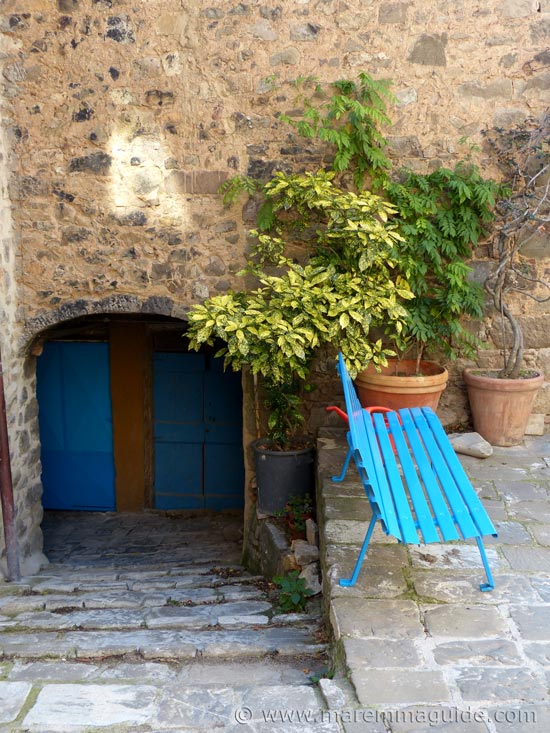

A little note. There aren't any bars or restaurants inside this castle. So if its a hot summer's day, or you have just finished-off a large crusty roll jammed with salty pecorino cheese and salami like I did, and fancy a coffee, you'll need to take your own water or wait until you reach Castel del Piano for a drink.
I did see an osteria sign as I drove down the lane, but didn't have time to investigate.

The tiny piazza at the centre of the castle; just room for one "pancina" (bench).
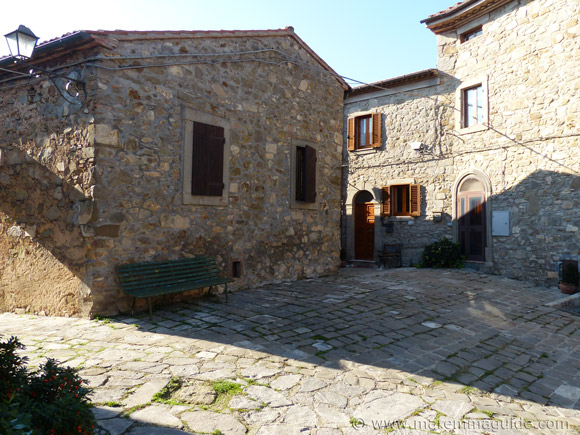
Getting around the castle: the alleyways and streets
This one has a tiny - modern-day - bridge above it that now connects one front door to another.
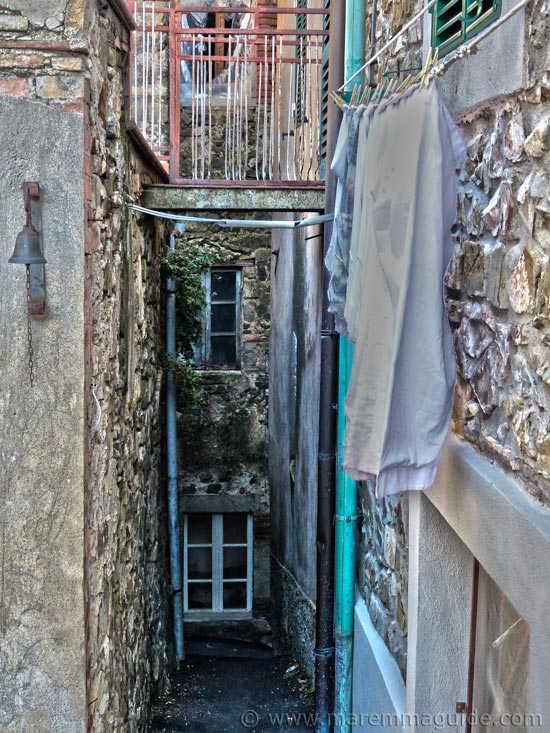

Mind your head.
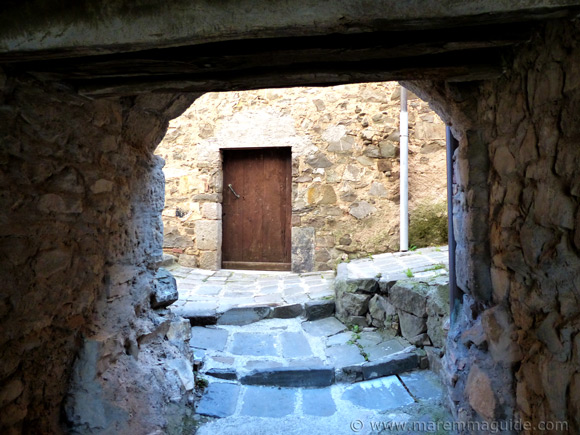
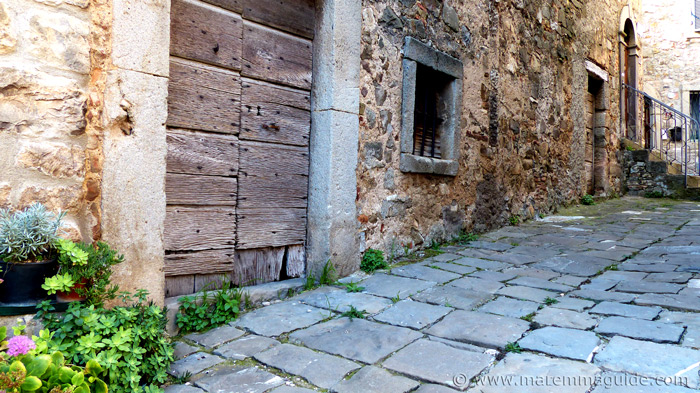
The open space of Piazza della Vittoria: the best place to park your car to explore the historic centre and where you will find the Church of San Martino.

The Chiesa di San Martino
The early fourteenth century - surviving records go back to the years 1302 to 1303 - church of the Chiesa di San Martino originally belonged to the Abbey of Sant'Antimo in Monte Amiata.
The bell tower was a later addition, but the arched doorway and elements of its frontage are original.
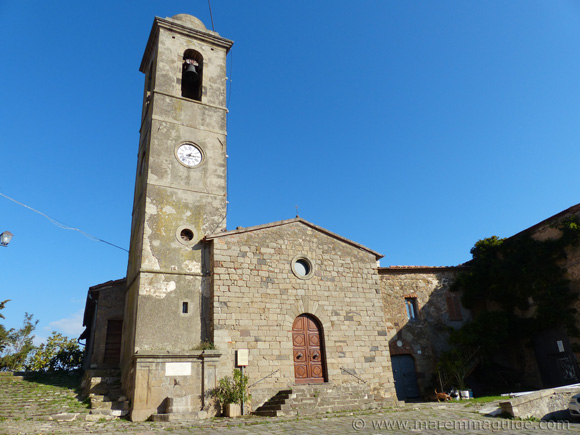
The Roman settlement
In 2012, at the bottom of the hill in the Ente valley, near where the rivers Ente and Zancona meet, two amateur archaeologists from Castel del Piano found the remains of a Roman settlement. A new, previously unrecorded, site.
A ten metre diameter, semi-circular building that itself sits on the crest of a hilly outcrop. Possibly an agricultural villa.
Monte Amiata still awaits its turn for its archaeological treasures from the Etruscan and Roman period to be discovered. Sporadic small discoveries during farm work - of tombs and burial grounds - have been made, but probably a lot go officially reported as the days work continues.
Montegiovi was known as "Mons Jovis" in Roman times, and nearby Seggiano as "Seius".
Like I said, not much to see ;)
Explore some more...
















